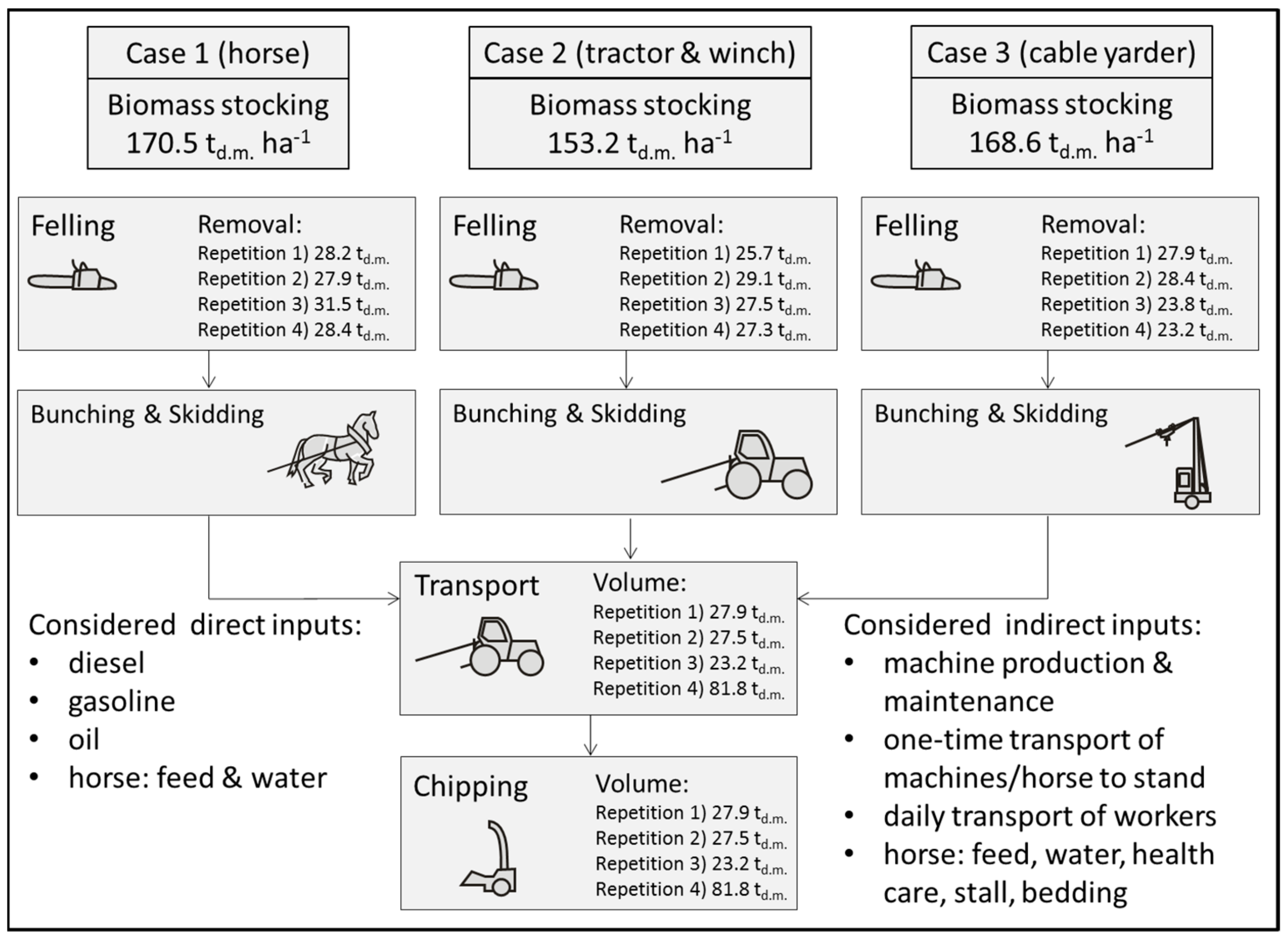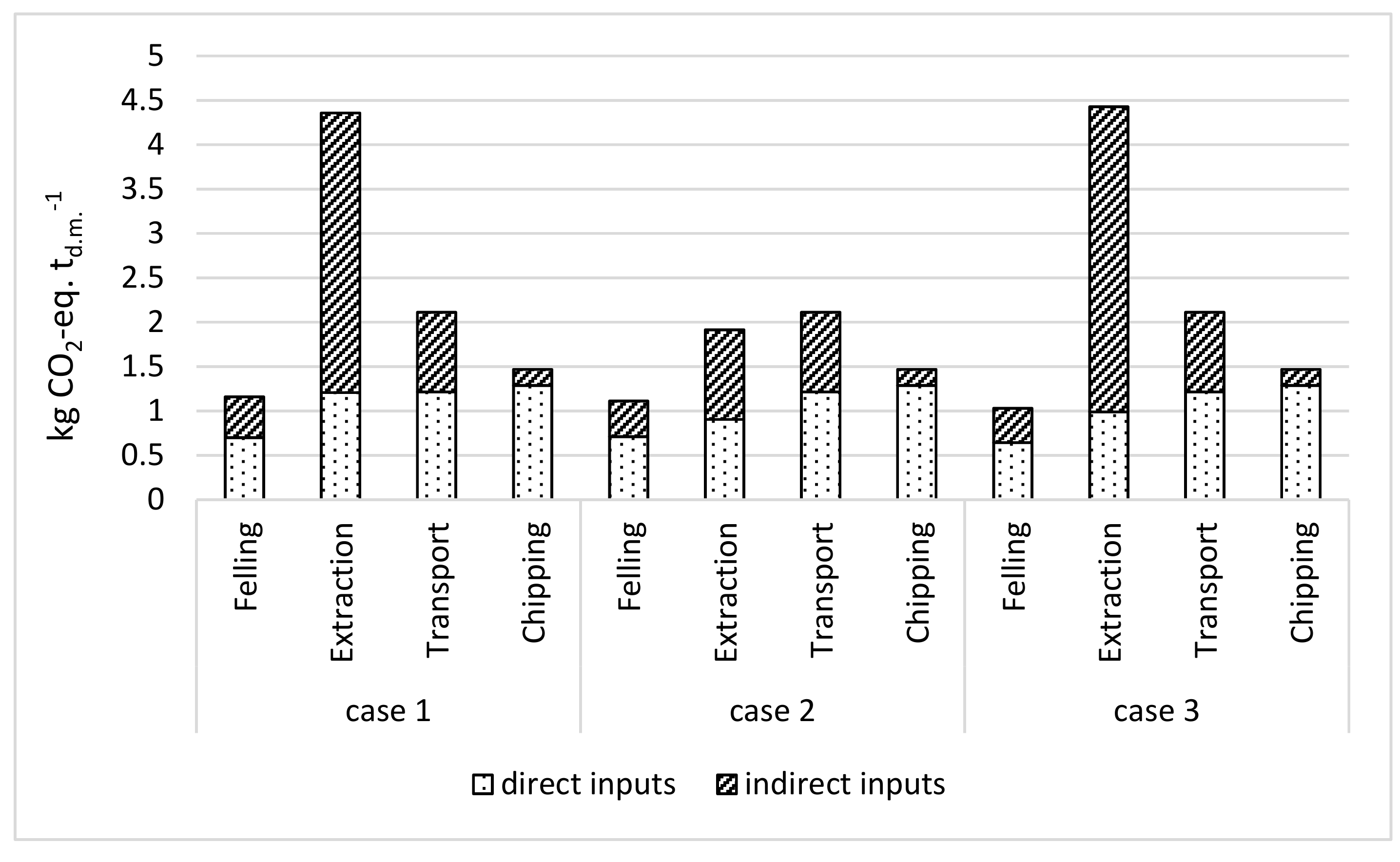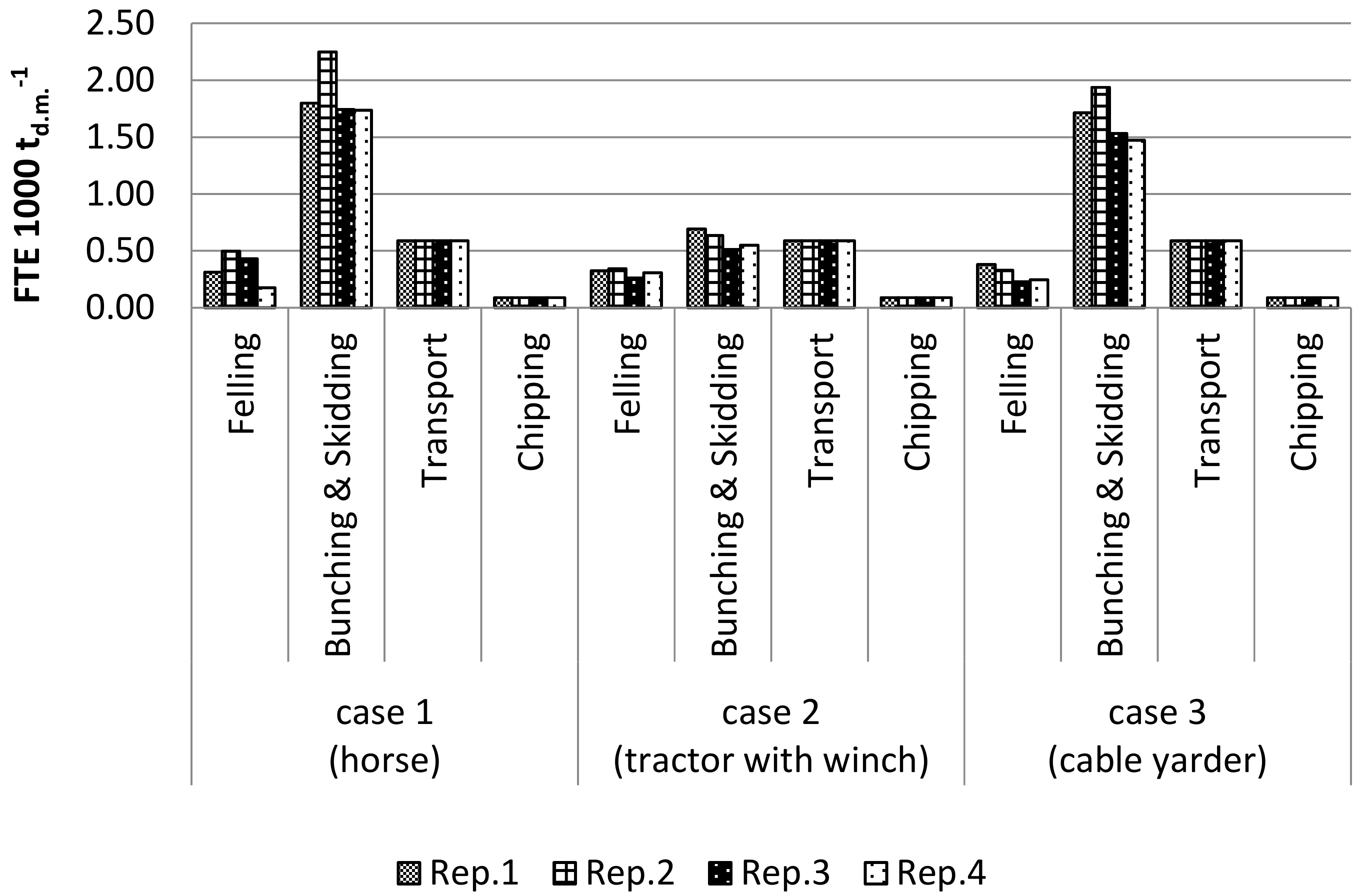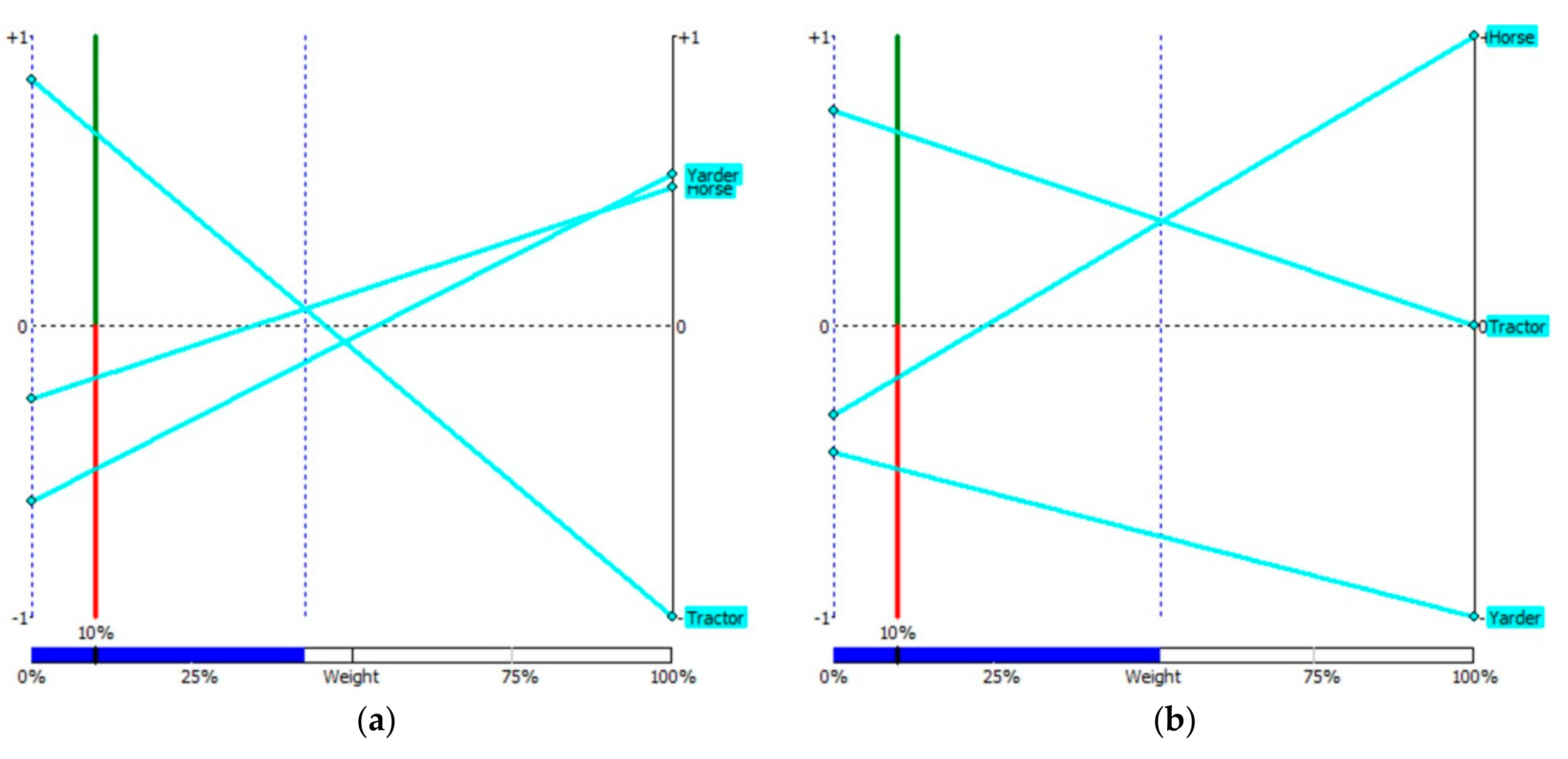1. Introduction
Mediterranean pines play a key role in the vegetation dynamics of the Mediterranean regions [
1]. This group of species includes
Pinus nigra Arnold,
Pinus brutia Ten.,
Pinus halepensis Mill., and others such as
Pinus pinaster Aiton, as the main representatives. These trees are well adapted to the fire regime that characterizes the area; they have a rapid and early growth and a general colonizing capacity; which all might explain why they have been traditionally used for afforestation projects and today often form extensive plantations in the overall Mediterranean basin. Afforestation was conducted mainly since the second half of the 19th century, aiming to improve protection functions (e.g., catchment hydrology and soil erosion) and socioeconomic functions [
2,
3,
4] after centuries of forest exploitation and conversion to agricultural areas [
5]. The total surface occupied by these pine plantations is estimated at 13 million ha, or 25% of the total forest area of the Mediterranean basin.
As many afforestation efforts lacked any kind of management, today, two main problems can be observed: First, many stands are in a poor physical and biological state with no dynamic processes [
6]. This is due to several factors (i.e., biotic and environmental adversity and the inadequate treatment). As one consequence, forest health will decline, the stability of forests will be reduced [
7], thus the permanence of land cover cannot be ensured.
Second, from a management perspective the pine-dominated vegetation is an intermediate step in succession to a climax state dominated by broadleaved trees [
3]. However, due to climate change, many stands expand far beyond the limits of their natural ranges [
7]. These changes are accompanied by a loss of biodiversity, a shift to non-site adapted tree species and a reduction of the resistance against climate inducted fluctuations, such as droughts, storms, insects and fungi [
7,
8,
9], and an active forest management is urgently necessary.
Consequently, in order to redirect plantations toward more natural densities, there is a strong need for silvicultural treatments, such as thinning [
10,
11,
12]. Different strategies exist to manage the pine plantations. They are mainly linked to renaturalization of artificial pine stands and consist generally in medium-high intensity thinning followed by a clear-cut after the affirmation of indigenous broadleaves seedlings [
13,
14,
15].
In all case, the thinning approach should be chosen carefully as, e.g., a selective thinning might cause a higher risk of crown fire when overtopped trees remain untouched [
16,
17].
Additionally, forest operations (FO) to implement this renaturalization strategy could have important impacts on environmental, economic, and/or social performances, hence on all pillars of sustainability [
18]. Forest Operations might affect carbon dioxide efflux [
19], porosity, bulk density, shear strength [
20], tree growth rate [
21] soil horizon mixing and topsoil removal [
22], and mineral soil respiration [
23].
In particular, extraction processes, such as forwarding and skidding, have a high potential for soil compaction [
24,
25,
26]. Further, damages to remaining stands might occur [
27] and lead to negative impacts on regeneration [
28].
It is well-known that fuel consumption is the most relevant contributor to greenhouse gas (GHG) emissions which cause global warming and thus, should be reduced [
29,
30]. Potential impacts in other environmental categories, such as the eutrophication potential (EP) and the acidification potential (AP) might be of particular interest when stands are included within natural reserves and underlie special conservation rules.
Further, with regard to social aspects, FO, especially when deployed on a low level of mechanization, is associated with a high risk of fatal accidents [
31,
32], particularly in felling and extracting operations.
Although in recent times there have been significant technological innovations in FO [
33], felling and extracting in Italy, also in many other countries of Europe, are often deployed by traditional methods; i.e., motor-manual felling with chainsaws and the use of mules and/or agricultural tractors for extraction (e.g., [
34,
35]). Cable yarding systems might be another suitable extraction method [
36].
To conclude, from a management perspective, there is an urgent need to apply silvicultural management strategies that support vegetation dynamics and enhance stand ecology, like the renaturalization concept. At the same time, the high and increasing demand of the forest based sector for wood biomass, related to energy productions, needs to be supplied.
The increasing global energy demand; the increasing fuel prices; the environmental impacts and the limited availability of fossil fuels; the aim to reduce emissions of greenhouse gases and to become more independent from fossil fuels, are some of the drivers why biomass resources are increasingly demanded for the production of renewable and sustainable energy. In contrast to wind and solar, biomass can provide base load capacity to the grid. In particular, the versatility of wood chips allows its flexible use in large heating plants, small combustion units and domestic boilers.
In a modern and multifunctional forestry, in which society is asking for sustainable forestry and naturalistic forest management [
7], FO should ideally be carried out in a sustainable manner and thus, support the concept of Sustainable Forest Management (SFM) [
18,
37,
38]. It aims to improve economic, but also environmental and social performances of forest processes, products and/or ecosystem services. All these aspects are also related to the innovation in forestry sector for an effective energetic sustainability. Indeed, renewable energy sources and the rational use of energy represent an important forestry resource in a local and global context against climate change.
It is a major challenge for decision makers (DMs) to consider the manifold consequences of decisions and to estimate the economic, environmental, and social performances of different alternatives before an action is carried out. Different indicators might have conflicting results and potential consequences should be known and taken into account in order to improve the silvicultural management strategies and respective methods of FO.
Therefore, the aim of this study was to assess possible impacts on sustainability that are related to FOs and resulting forest wood chains supporting the renaturalization strategy in typical afforested pine plantations in the Mediterranean basin. To be more concrete, we aimed to (i) identify alternative FOs that are suitable silvicultural actions for renaturalization of the pine stands, thereby putting a special emphasis to the extraction process; (ii) assess the potential impacts on all three pillars of sustainability; and (iii) make comprehensive evaluations of the alternative forest wood chains in order to support DMs. To do so, the method of sustainability impact assessment (SIA) was used. It supports assessing economic, environmental and social dimensions of forest processes, products and/or ecosystem services aiming to improve them [
39].
In addition, a multi-criteria decision analysis (MCDA) was applied to support DMs. Forestry decision making is a very complex issue that requires consideration of trade-offs among different criteria (or indicators) [
40]. MCDA is described by Belton and Stewart 2002 [
41] “as an umbrella term to describe a collection of formal approaches, which seek to take explicit account of multiple criteria in helping individuals or groups explore decisions that matter.” In other words, MCDA handles the process of making decisions in the presence of multiple, usually conflicting, criteria and provides a formal model to compare a finite number of alternatives on a one-dimensional preference scale [
42]. MCDA has been widely used as decision-support tool in forest management [
40,
43] and FO [
44,
45].
4. Discussion
This study showed results from a case study that was carried out in a 60 year old black pine stand in the Abruzzo region in Italy. The mainstream silvicultural prescription for these stands is two to four thinning operations, followed by clear-cutting and replanting or renaturalization.
In this case, the forest management goal was to ensure the partial permanence of land cover, with the gradual replacement of pine with late successional tree species that are typical of more mature stages of evolution. Clear-cutting on strips was conducted as silvicultural operation with the aim to eliminate 50% of the surface of the plantations, and thereby to support natural renaturalization.
Thinning operations can be carried out by using many harvesting systems. The most popular are cut-to-length and whole-tree harvesting. The latter was applied in this study. However, different extraction processes were conducted (
Figure 1 and
Figure 2): In case 1, extraction was conducted by animal (heavy rapid skidding horse, TPR-horse), in case 2 extraction was conducted by, forestry-fitted farm tractor with winch, and in case 3 extraction was conducted by double drum cable yarder. After extraction, trees were transported to the landing, where the trees were chipped for energy purposes, which is a common procedure. All forest wood chains were repeated four times.
One of the most challenging tasks in forest management is to consider the consequences of different strategies or FO and to estimate the economic, environmental and social performance of each alternative before an action is carried out. It is important to consider different pillars of sustainability and to link environmental impacts to socio-economic activities in order to guide DMs in their actions and to ensure that the impacts of their decisions are measured.
Therefore, the aim of the study was to conduct a SIA aiming to assess potential impacts on sustainability that are related to FO being applied to support the renaturalization strategy in typical afforested pine plantations in the Mediterranean basin.
The system boundaries included all processes necessary for turning standing trees in the forest into whole-tree chips loaded on trucks and ready for delivery to the mill. Twelve indicators were considered to be important and feasible with regard to data collection.
Input data were gathered from field studies (as reported in [
46]) and respective indicator values were calculated by the use of different tools; e.g., potential environmental impacts of exhaust gases under the use of the Ecoinvent database and Umberto, a tool for LCA.
Recent studies have shown that that there are few studies related to FO considering all pillars of sustainability [
38]. Most studies are focused only on either environmental or on economic and environmental aspects. However, the use of several indicators and the combination of different methods to calculate indicator values leads to a strong analytical power for embracing financial, technological, environmental, and other aspects of a production system [
30].
Different software tools exist to conduct a SIA [
81], including within the context of forestry (e.g., TOSIA, as presented by [
39,
47,
82]). We decided to use a LCA software tool for modelling and analysis, because the method of LCA was used to determine potential environmental impacts, and in the software used, SI other than environmental ones can be defined and added, too.
In all three cases, a team consisting of two workers was necessary to conduct the working processes. Resulting system productivity was highest in case 2. Felling was always conducted motor-manually; there were differences between the cases: The average cutting productivity was low in case 2, when trees could be felled non-accurate orientation. The reason was that the two workers struggled less as the trees were felled based on their natural inclination, but this led to a maze of crossed trees on the ground or situations of hanging trees. Therefore, materially, their proceedings were very often difficult and confusing. The result was higher working times than the oriented felling.
It turned out that the most time-consuming process was bunching and skidding. It reached the highest productivities in case 2, followed by case 1 and case 3 (
Table 4). When considering average tree diameters (18–24 cm) and steepness of the terrain (50%) the delays in case 1 might be explained (39% of the total working time of bunching and skidding). In case 3, a high share of the total working of bunching and skidding time was spent on hooking and unhooking (34%) and the share of delays was quite high, too (43%). This could be related to the average tree low dimensions, that for yarder extraction needed mainly one chain for tree, with consequential hooking and unhooking time increasing. In contrast, using a tractor with a winch is a common method to extract trees in the case study region. Thus, operators were experienced and spent less working time on hooking and unhooking (24%) and had fewer delays (30%). More training with a yarder would probably lead to an increase in productivity, too.
Costs followed the same pattern and were almost 2.5 times lower in case 2 than in case 3. These figures are quite impressive when indicator results were scaled up to hectares (
Table 8), and when considering that there are about 13,000 ha black pine plantations growing in the studied area. To give an example: Managing all plantations with the harvesting systems and machines presented in case 2 would result in total costs of million € 62.4 while it results in million 168.7 when choosing the harvesting systems and machines presented in case 3.
It has to be noted that, in contrast to productivity and costs, the employment (#8 EMP) was highest in case 3 due to the above-mentioned reasons, followed by case 1 and case 2 (
Figure 5). Decision makers should have in mind (i) which infrastructure is given in a specific region (e.g., would a yarder be available?); (ii) that it is increasingly difficult to find skilled labor; and (iii) consideration for the question of which possibilities for rural development of an area there are.
LCA results showed that the cumulated energy demand of fossil energy was lowest in case 1, followed by case 2 and case 3. This fact can be explained by the amount of fuels required by machines. However, surprisingly, the share of indirect emission was quite high (
Table 6,
Figure 4). For example, it was 38% in the process bunching and skidding in case 1, mainly caused by the daily transport of workers (35 km/way) and the “impact” of the horse on non-working days. It was also high in case 3 (36%) due to the production and maintenance of the yarder.
The potential impacts in the environmental categories global warming potential, eutrophication potential, and acidification potential all followed the same trend (
Table 6): Extraction by tractor with a winch resulted in lowest impacts. As inputs were not exclusively, but mainly, fuels we can ascribe to facilitating high productivity and thus, lower fuel consumption reached in case 2.
In mountains areas, the plantations and treatment operations related to re-forestation, had strong and variable effects on plant species occurrence and diversity due to the alteration of ecological processes [
83]. However, these plantations contributed to biodiversity conservation in various ways, as found by Poorbabaei and Poorrahmati [
84]: A high similarity in species composition between plantation and the adjacent natural forest, which is the main source of seed in plantations, was present. The actual necessity of an active management of pine plantations could have strong and variable effects on plant species’ occurrence and diversity due to treatment operations and canopy cover changes.
As found by Picchio et al. [
46], both silvicultural treatment and FO applied in this research, showed changes on density, richness, and biodiversity of tree species in only three years after harvesting. The good density and richness of tree species in this pine plantation indicate the high potential reached by the stand for biodiversity restoration, following what was found in other studies [
85,
86].
Referring to stand regeneration, different taxonomic compositions of the tree forest community among the cases are shown, in particular in the percentage of distribution, showing a simplification in case 1 with respect to the others. In general, in the cases 1 and 2 (ground-based logging) allowed for the presence of Robinia pseudoacacia and only marginal Pinus nigra regeneration.
The treatments applied showed a positive effect to the SI tree regeneration density, with greater consistency in the cases 2 and 3; compared to the control, they showed increases of 85% and 72%, respectively. The case 1 showed a positive trend, with an increase of about 69% compared to the control.
Other important ecological aspects were assessed, such as the tree richness and diversity of tree species; in particular the tree species diversity was chosen. The case 2 had higher richness values than the control and the cases 1 and 3. However, it is important to note that the data presented so far concern a limited period of time; more time is needed to further evaluate whether the cutting effect on biodiversity will last long [
87,
88].
Indicator values of the SI soil biological quality showed for the three cases an impact, and the observed variation is explained by the different degrees of soil compaction and the abundance of litter associated with sudden stand removal [
59,
89]. The QBS-ar values were lowest in the case 3, followed by the case 1. The best situation was found for case 2. In addition, the SI soil microarthropod community density was assessed, and, as can be observed from the data gathered, it was impacted by FOs. Case 2 had higher values than the cases 1 and 3.
To help DMs judging these results, a MCDA was conducted. Weights of criteria were obtained using the DIRECT method. As shown in
Table 9, the SI tree regeneration density and soil biological quality were set as most important criteria, because they support the achievement of the forest management goal, followed by the environmental criteria cumulated energy demand, global warming potential, eutrophication potential and acidification potential, while the least important criteria were tree species diversity, soil microarthropod community density, employment, and COSTs (with a weight of 0.050). This decision was related to DMs’ intention to give higher priority to environmental criteria. The two SIs productivity and delay were excluded from the MCDA because they were included in other SI, e.g., in Costs.
For the ranking of alternatives (cases), two different MCDA methods were applied, namely MAUT and PROMETHEE. They have different philosophies, and therefore often produce different results (rankings), but here, this was not the case. The main reason for that lies in a fact that first ranked alternative (case 2) had best performance for eight (out of 10) criteria. Only for the two criteria, employment and soil biological quality, other alternatives had better performances. Because of that, a sensitive analysis was carried out aiming to estimate how much one needs to change (increase) the weights of those two criteria—employment and soil biological quality—in order to change first ranked alternative (
Figure 6 and
Figure 7). From the results of the sensitive analysis, we can conclude that case 2 is a very stable first ranked alternative and can be selected as the best one for this case study. Worthy of mention is that the results of the MCDA process were presented to participating individuals; i.e., DMs. No significant complaints by DMs were made about the ranks of analyzed alternatives. Overall, presented approach can improve (and simplify) decision making process and may help experts (or DMs) to select the best alternative for given context.
5. Conclusions
In the preceding years, several changes were ongoing the forest world; for example, the growing interest in sustainability, due to the new awareness of people about the importance of forests from environmental and social points of view, which increased the need of having strong and reliable instruments for decision makers (DMs) to optimize choices in order to satisfy all forests’ stakeholders and interests.
From this perspective, this paper was born with the aim to assess possible impacts on sustainability that were related to FO and the resulting forest wood chains to support the renaturalization strategy in typical. afforested pine plantations in the Mediterranean basin. In detail, three main topics were studied in order to: (i) Identify alternative FO concerning silvicultural actions suitable for renaturalization of the pine stands, thereby putting a special emphasis to the extraction process; (ii) assess the potential impacts on all three pillars of sustainability; and (iii) make comprehensive evaluations of the alternative forest wood chains in order to support DMs.
In order to reach aim the first aim, a SIA and a MCDA were conducted for three different extraction methods in pine stands thinning operations, considering Mediterranean setting. In particular, the analyzed extraction systems were: TPR horse, forestry-fitted farm tractor with a winch, and double drum cable yarder. Obtained results showed that a tractor with a winch was clearly the best alternative, since it showed the best performance for eight out of 10 investigated variables. Thus, it can be said that a forestry-fitted farm tractor with a winch was the best alternative from an economic, environmental, and social point of view. This result was reached setting the SIA and MCDA with particular attention to the environmental aspects, considering that study area is located in a Natural Reserve and that the most important aim of the silvicultural intervention was not economic gain but renaturalization.
The specific result focused on the second aim showed a detailed assessment of FO consequences on all three pillars of sustainability. From economic point of view, only cable yarder showed no positive results, more related to the silvicultural treatment applied. TPR-horses and a tractor with a winch, instead, reached good economic performance. About environmental pillar, all FO applied in this research showed changes on density, richness, and biodiversity of tree species in only three years after harvesting. Indicator values of the QBS-ar showed an impact for the three cases, so one might say that soil ecosystem restoration, in this case, is slower than forest stand one. However, for all these parameters, tractors with winches showed the best values. Concerning the social point of view, it can be said that all three extraction methods had the same labor requirements. In central Italy’s context a TPR-horse and the tractor with a winch are the best-known extraction methods, and this partially explains the cheap results of a cable yarder from economic point of view. In this context, an improvement in cable yarder use, linked to workers’ proper formation, should be recommended; however, that should consider the conditions of high slopes and lack of viability of central Italy forest, in particular, pine stands.
These are important results that fit with one of the major challenges of forest management, regarding the consequences of different management strategies or FOs, by assessing the economic, environmental, and social performance of each individual option before an action is carried out.
Focusing around the third aim, it was possible to affirm that tractor with winch resulted to have the best performance from all point of views, and it represented the best choice for pine stands renaturalization interventions. In fact, it combined good productivity and so quite low costs, contained environmental impacts and good recovery capacity of pre-intervention conditions, and optimum knowledge of its functioning and safety rules of work by central Italy forest workers.
In relation to cable yarder it was important to underline how the poor performances were mainly linked to the silvicultural treatment design (strips of 100 m length were a limit for this equipment).
On the other hand, obtained results confirmed what detected in other previous studies about extraction with animals. The general performances of this extraction methodology were often worse than mechanical ones, not only related to productivity aspects but also to environmental impacts. Even though in this study a TPR-horse resulted to be a good alternative to cable yarder.
Finally, it was possible to say that SIA and MCDA showed satisfying performance in analyzing FO alternatives and thus they resulted to be strong instruments to support DM; and this is very important in the perspective of reaching a sustainable forest management, which leads to satisfy all three pillars of sustainability.















